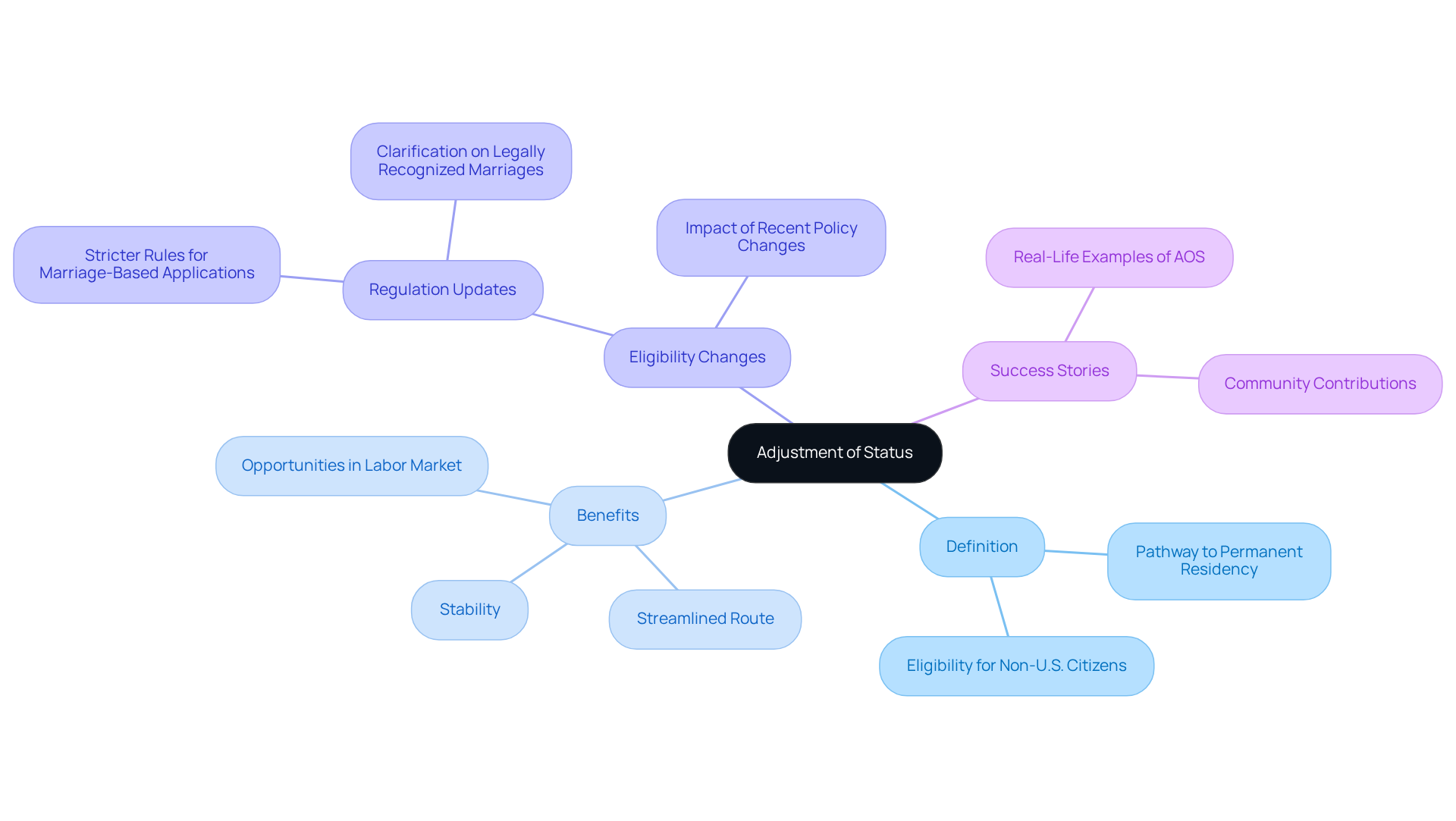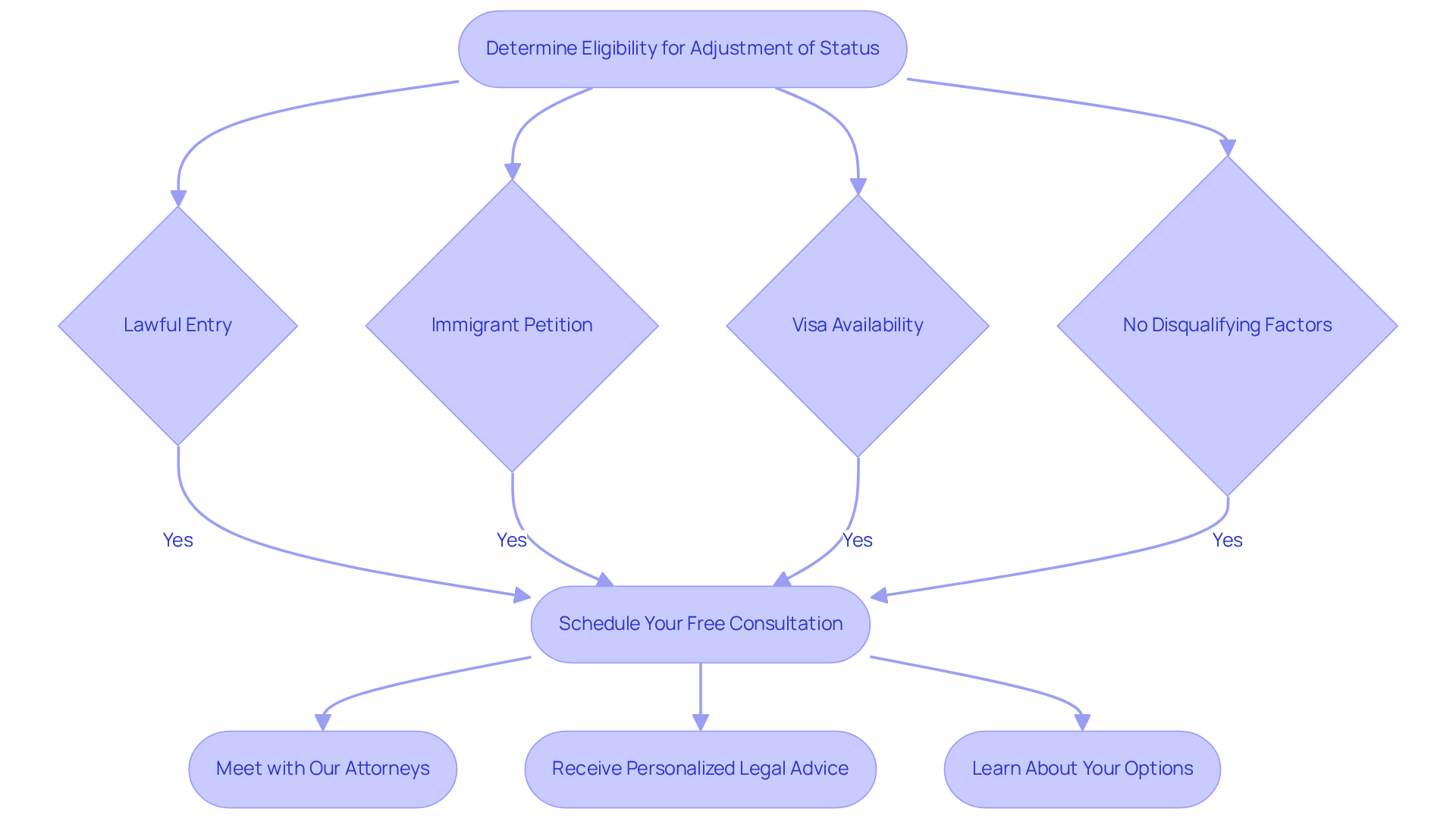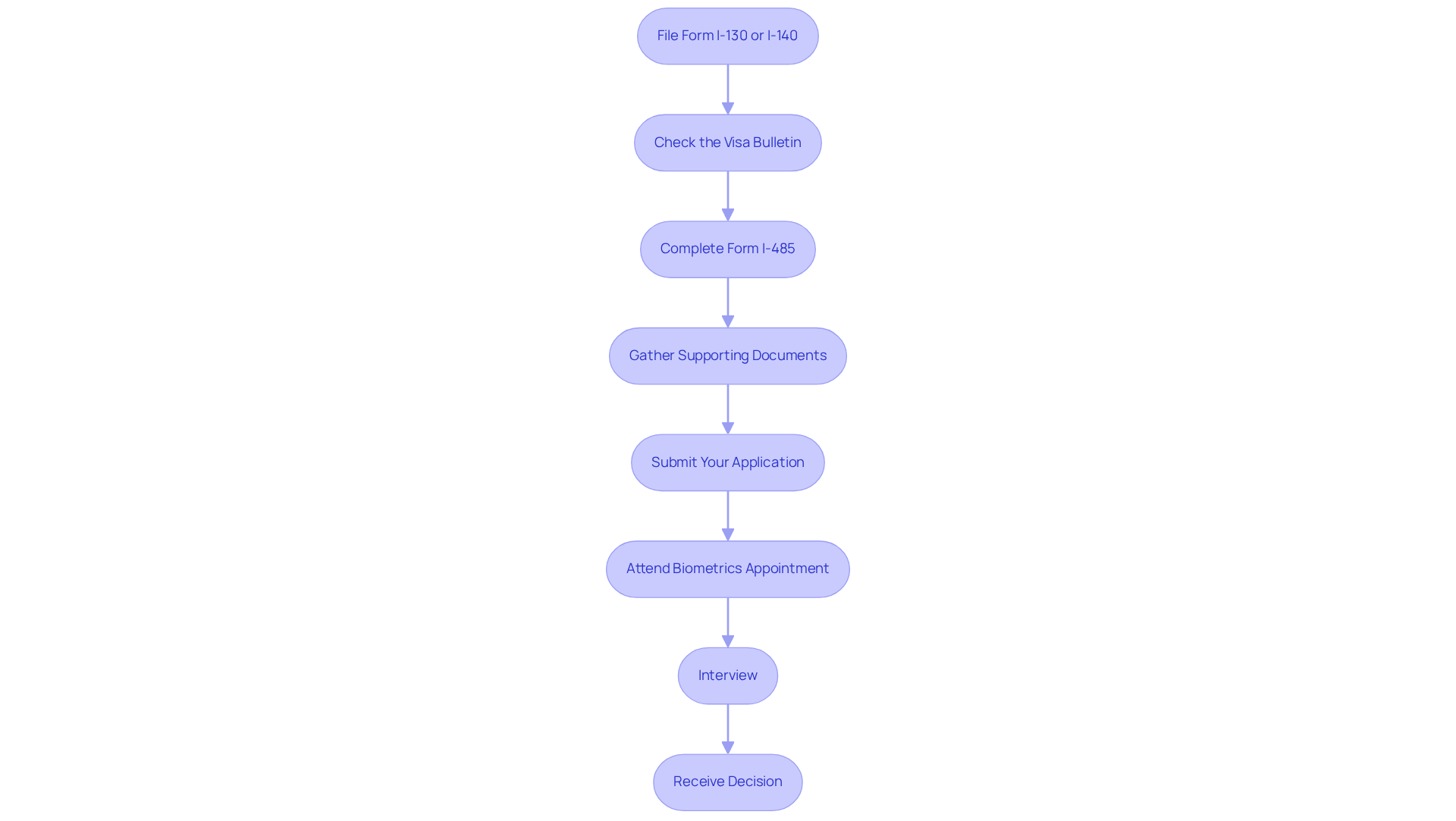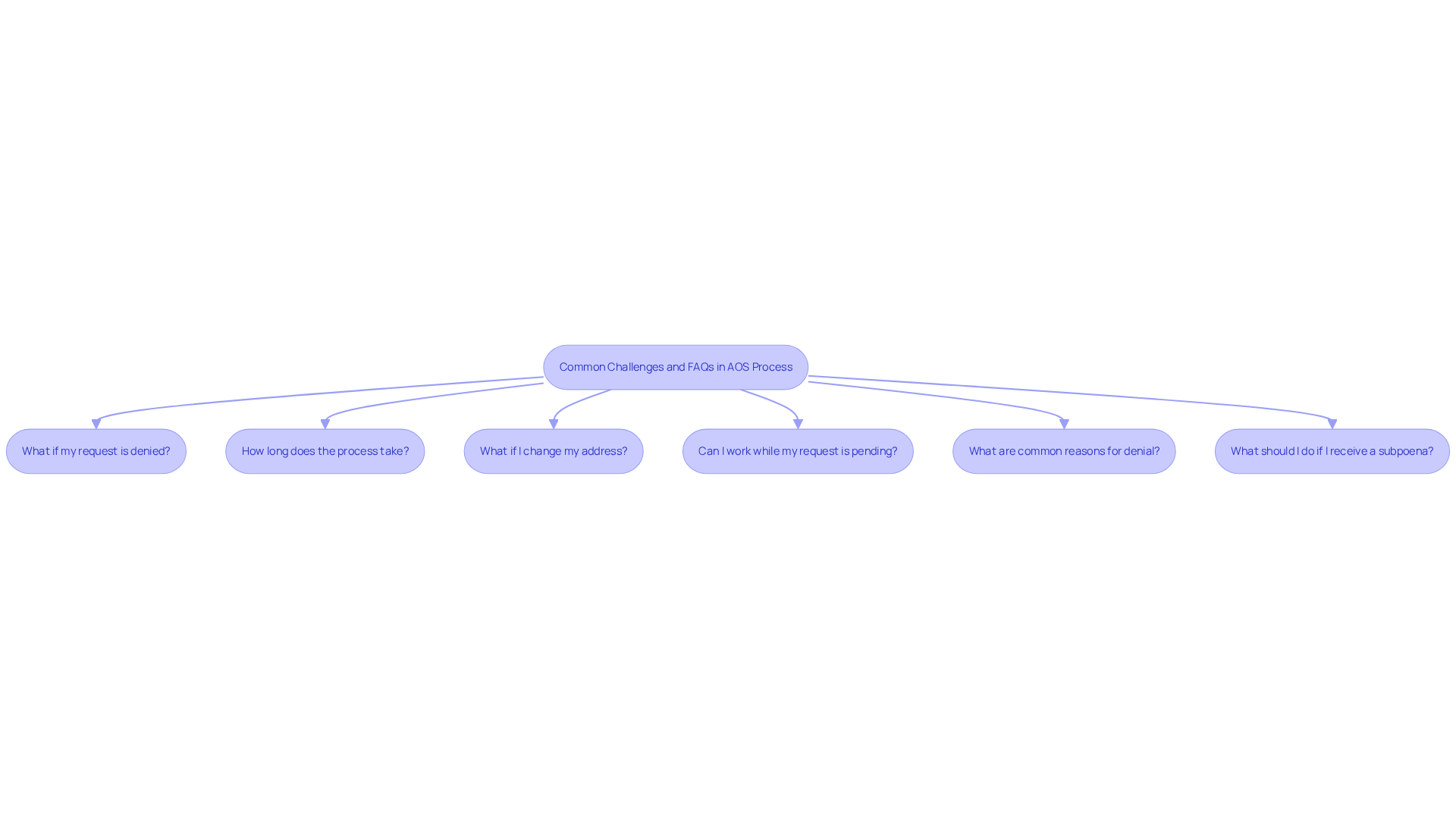Overview
The article titled "Master Adjustment of Status: A Step-by-Step Guide for Immigrants" aims to illuminate the adjustment of status (AOS) process for non-U.S. citizens seeking permanent residency. It recognizes the real struggles faced by many, such as navigating confusing immigration processes.
This guide outlines essential eligibility criteria and provides a detailed application process. It also addresses common challenges, emphasizing the importance of thorough preparation and legal support to enhance the chances of a successful AOS application.
Remember, you don’t have to face this journey alone—we’re here to fight for your family.
Introduction
Navigating the complex landscape of U.S. immigration can often feel like an uphill battle. For those seeking to transition from temporary visas to permanent residency, the adjustment of status (AOS) process is a vital pathway. It allows eligible non-U.S. citizens to secure a Green Card without leaving the country.
This guide aims to demystify the AOS journey, highlighting the numerous benefits it offers—from enhanced stability to greater employment opportunities. However, with evolving regulations and common pitfalls, many may wonder:
- What are the key steps to ensure a successful application?
- How can applicants effectively overcome the challenges that lie ahead?
We understand how overwhelming this feels, but you don’t have to face it alone—we’re here to fight for you.
Understand Adjustment of Status
The (AOS) is a crucial process that enables eligible non-U.S. citizens to apply for without having to leave the United States. This pathway is particularly advantageous for individuals , enabling them to while continuing to live and work in the country. As we look ahead to 2025, a are expected to pursue adjustment of status, highlighting its vital role in the immigration landscape.
The benefits of AOS are numerous. For many immigrants, it offers a streamlined route to , leading to greater stability and opportunities in the U.S. labor market. Recent updates in AOS regulations have clarified eligibility requirements for adjustment of status, making it essential for applicants to stay informed about the . For example, the USCIS has instituted stricter rules regarding , highlighting the necessity for legally recognized marriages.
Real-life stories illustrate the effectiveness of AOS. Many individuals have successfully navigated this process, moving from temporary status to permanent residency, which has allowed them to build their lives and contribute to their communities. These of adjustment of status on immigrants' lives, reinforcing its significance as a critical step toward establishing a stable future in the United States.

Determine Eligibility for Adjustment of Status
To qualify for (AOS), applicants must satisfy several essential criteria:
- Lawful Entry: You must have been inspected and admitted or paroled into the United States. Entering unlawfully excludes you from this process.
- Immigrant Petition: An immigrant petition, typically Form I-130 or I-140, must be filed on your behalf. However, exceptions exist for certain categories, such as asylum seekers or special immigrants.
- Visa Availability: A visa must be available in your category at the time of filing. You can check current visa availability through the , which provides updates on family-based and employment-based categories.
- No : You must not be subject to any disqualifying factors, including specific criminal convictions or immigration violations that could bar adjustment.
To ensure you meet these criteria, we encourage you to schedule a with Vasquez Law Firm. The consultation process includes the following steps:
- Schedule Your Free Consultation: Contact us to set up a time that works for you.
- Meet with Our Attorneys: in a one-on-one meeting.
- Receive : Our attorneys will provide tailored guidance based on your situation.
- Learn About Your Options: and options available to you.
Failure to reply to requests for extra evidence or missed appointments can lead to significant delays or even rejection of your submission. Consulting with an is highly recommended to assess your unique situation and confirm that you meet all eligibility requirements. Understanding these legal entry prerequisites is crucial for a successful adjustment of status application. Many immigrants have effectively navigated these criteria with the right support throughout their journey.

Follow the Step-by-Step Application Process
Navigating the (AOS) application process can feel overwhelming, but breaking it down into essential steps can empower you to achieve a successful outcome:
- File Form I-130 or I-140: If your request is based on family or employment, your sponsor must submit the appropriate immigrant petition to kick off this journey. The [adjustment of status](https://vasquezlawnc.com/practice-areas) is a crucial step in the immigration process.
- Check the : Before filing , confirm that a visa is available in your category. Remember, priority dates dictate your eligibility.
- Complete Form I-485: Take your time to accurately fill out Form I-485 for your adjustment of status. Make sure all required information and documentation are included—this can save you from delays.
- Gather : Collect necessary documents like your passport, birth certificate, medical examination results, and proof of lawful entry into the U.S. It’s crucial to have everything in order.
- Submit Your Application: Send your completed I-485 form along with the required fees and supporting documents to the appropriate USCIS office. Organizing your materials can make a difference.
- Attend Biometrics Appointment: After submission, expect a notice for a biometrics appointment where your fingerprints and photo will be taken, usually within a few weeks. This is a standard part of the process.
- Interview: In some cases, you may be required to attend an interview at a USCIS office. Prepare by reviewing your submission and supporting documents thoroughly—it’s your chance to clarify any doubts.
- Receive Decision: After processing, you will receive a decision regarding your adjustment of status request. If approved, you will be granted , a significant milestone.
By following these steps, you can greatly enhance your chances of a . Recently, the number of Form I-485 submissions has surged, with over 100,000 requests lodged in the last fiscal year alone. This indicates a growing interest in permanent residency. Understanding the and preparing adequately are essential for reaching your . Additionally, be aware of recent changes in the USCIS submission method, including revised criteria for supporting documents and processing times. Consulting with can provide valuable insights and real-life examples of successful I-485 submissions, further enhancing your understanding of the process. Remember, you are not alone in this fight—we’re here to support you every step of the way.

Address Common Challenges and FAQs
Navigating the (AOS) process can be daunting, especially when facing urgent legal situations. Here are some common issues and FAQs to help you through:
- What if my request is denied? If your application is denied, you will receive a notice detailing the reasons for the denial. Depending on the circumstances, you may have the option to appeal or reapply. For instance, missing documentation accounted for nearly 61,696 denials in family-based cases, highlighting the importance of thorough preparation. As M.E. Hammond emphasizes, "Ensuring all documentation is complete and accurate is crucial to avoid unnecessary setbacks."
- How long does the process take? based on individual circumstances and the current workload at USCIS. As of 2025, the average processing time for adjustment of status requests is approximately 11 months, but it can take several months to over a year depending on the field office and other factors.
- What if I change my address? It is essential to notify USCIS of any address changes promptly. Neglecting to do so may lead to missed communication regarding your submission, causing complications or delays.
- Can I work while my request is pending? If you have filed for AOS, you can apply for an Employment Authorization Document (EAD). This enables you to work legally while your request is being processed, offering financial stability during the waiting period.
- What are ? Common reasons for the denial of adjustment of status submissions include incomplete submissions, failure to meet eligibility requirements, and issues related to criminal history. that ensuring all documentation is complete and accurate is crucial to avoid unnecessary setbacks. Political changes can also impact the movement of people, making it vital to stay informed about potential effects on your application.
- What should I do if I receive a subpoena or face immigration enforcement? In urgent situations, such as receiving a subpoena or facing ICE enforcement actions, it is critical to act immediately. Know your rights: , the right to an attorney, and the right not to sign documents without legal counsel. Do not open your door unless ICE has a warrant signed by a judge. If you find yourself in such a situation, exercise your right to remain silent and request an attorney immediately. for emergency legal assistance. Your rights and freedom may depend on immediate action.
By being aware of these challenges and preparing accordingly, you can with greater confidence. Remember, you are not alone in this fight—we’re here for you.

Conclusion
Adjustment of Status (AOS) is more than just a process; it’s a vital pathway for non-U.S. citizens seeking lawful permanent residency while remaining in the United States. This journey not only facilitates a smoother transition from temporary to permanent status but also opens doors to enhanced stability and opportunities in the U.S. labor market. As the immigration landscape evolves, understanding the nuances of AOS becomes essential for those aiming to establish a lasting presence in the country.
Throughout this article, we’ve explored key aspects of the AOS process—eligibility criteria, the step-by-step application process, and common challenges faced by applicants. It’s crucial to meet specific requirements, such as lawful entry and having an immigrant petition filed, for a successful application. Real-life success stories illustrate how AOS can transform lives, underscoring its significance as a critical step toward building a secure future in the U.S.
Navigating the AOS process can feel daunting, but with the right knowledge and support, it can lead to successful outcomes for many immigrants. Staying informed about the latest regulations, preparing thoroughly, and seeking legal guidance are essential strategies for overcoming potential obstacles. As the demand for adjustment of status continues to rise, we encourage you to take proactive steps in pursuing your immigration goals. Remember, you are not alone in this journey—we’re here to fight for your family and ensure you are well-equipped for the road ahead. Your future matters to us. Yo Peleo — We Fight.
Frequently Asked Questions
What is the adjustment of status (AOS)?
The adjustment of status (AOS) is a process that allows eligible non-U.S. citizens to apply for lawful permanent resident status (Green Card) without leaving the United States.
Who can benefit from the adjustment of status process?
Individuals currently in the U.S. on temporary visas can benefit from AOS, as it enables them to transition to permanent residency while continuing to live and work in the country.
Why is adjustment of status important for immigrants?
AOS provides a streamlined route to permanent residency, leading to greater stability and opportunities in the U.S. labor market, making it a vital option for many immigrants.
What recent updates have been made to AOS regulations?
Recent updates have clarified eligibility requirements, including stricter rules regarding marriage-based green card applications, emphasizing the need for legally recognized marriages.
Are there any real-life examples of successful adjustment of status applications?
Yes, many individuals have successfully navigated the AOS process, moving from temporary status to permanent residency, which has allowed them to build their lives and contribute to their communities.
What is the expected trend for AOS applications in the coming years?
A significant percentage of immigrants are expected to pursue adjustment of status as we look ahead to 2025, highlighting its importance in the immigration landscape.




